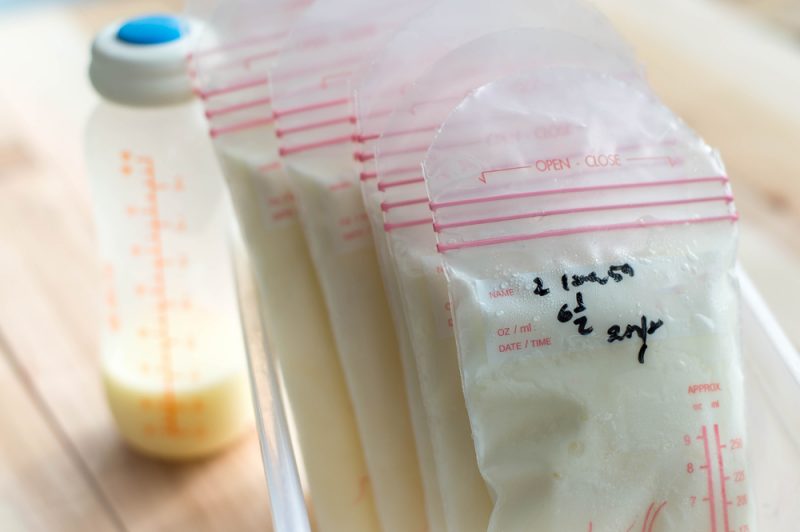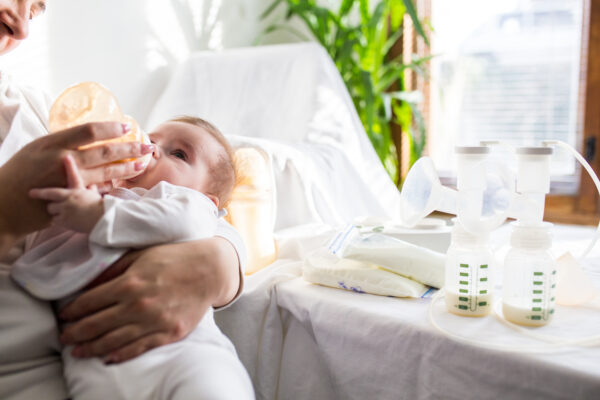 Though pumping can be a pain — literally — when you need to be away from your baby, it’ll all be worth it. Pumping can help you get some much-needed rest and let your baby’s father bond with and feed her. Plus, it allows you to continue breastfeeding even after you return to work.
Though pumping can be a pain — literally — when you need to be away from your baby, it’ll all be worth it. Pumping can help you get some much-needed rest and let your baby’s father bond with and feed her. Plus, it allows you to continue breastfeeding even after you return to work.
Pumping can be frustrating at first. If suction is too high, or the pump flange or shield is too small or is placed incorrectly over the nipple, it can be uncomfortable and you’ll be less likely to get the milk you need.
Plus, it takes practice and patience to produce enough milk when you’re faced with a machine instead of your cute, cuddly baby. So, don’t be discouraged if it takes a few pumping sessions to express enough milk for a full bottle.
Some moms find they express more milk when their baby is close by, or if they look at a picture or video of their baby, smell a piece of baby’s clothing or favorite blanket, or incorporate gentle massage.
“To get the most of your output, be sure to adjust the pump’s speed and suction settings to the level that’s comfortable for you,” said Carly Dulabon, MD, certified lactation consultant and director of Breastfeeding Medicine at Akron Children’s. “Also, make sure the breast shield covers your entire nipple and areola, and has a good seal. If you’re struggling with pumping, talk to a lactation specialist. We’re here to help!”

It’s a good idea to start pumping about 2 to 3 weeks before returning to work to build up milk supply. Plus, it gives your baby time to learn to drink from a bottle.
Moms should pump every time they miss a feeding, or at least every 3 hours after returning to work. It’s a good idea to start pumping about 2 to 3 weeks before returning to work to build up milk supply. It also will give you time to practice with the pump and allow baby time to learn to drink from a bottle.
Dr. Dulabon suggests pumping after your first morning feeding. You’ll want to store up about 20 to 30 ounces, she says, enough for your first day back and in case of emergencies.
“There are cases, however, when mom may need to pump sooner,” she continued. “For example, if your baby is having difficulty latching, not gaining weight well or is in the NICU and requires separation from mom.”
Once you’re comfortable pumping and have the expressed breast milk, properly storing it is vital to building a stash of “liquid gold.” Dr. Dulabon offers do’s and don’ts to properly storing and thawing your breast milk for times when you’re away.
Do’s for storing and thawing your breast milk
- Do store your breast milk in clean bottles with screw caps or nursing bags (pre-sterilized bags meant for breast milk). Don’t use disposable bottle liners or plastic bags that aren’t intended for storing breast milk.
- Do label each container with the date when the milk was expressed and your baby’s name if taking to childcare. Milk doesn’t necessarily expire, but vital nutrients can diminish over time.
- Do store it at room temperature (for up to 6 hours), in the refrigerator (for up to 5 days) or in a freezer (for up to a year). When freezing breast milk, store in small amounts, about 3-to-4-ounce portions, to avoid waste.
- Do clean pumping supplies with hot, soapy water after each use and let them air dry. Keeping your parts clean is important to prevent the introduction of harmful bacteria to your baby’s breast milk. If baby is in the NICU, follow hospital recommendations for sterilizing pump parts.
- Do thaw your breast milk in the refrigerator or under warm water until it reaches the desired temperature.
Don’ts for storing and thawing your breast milk
- Don’t refreeze thawed breast milk. Once thawed, use the milk within 24 hours. Once your baby has started to drink from the bottle, you should use it within 2 hours.
- Don’t microwave breast milk. It can destroy important components and create hot spots that can scald baby’s mouth.
- Don’t store breast milk in the door of a refrigerator or freezer because the temperature can vary from it opening and closing. Instead, place it in the back.
- Don’t fill milk storage bags all the way to the top. Breast milk expands when it freezes.
For more information on breastfeeding, expressing and storing breast milk, contact Akron Children’s Breastfeeding Medicine at 330-543-4500. Virtual Visits are available.











